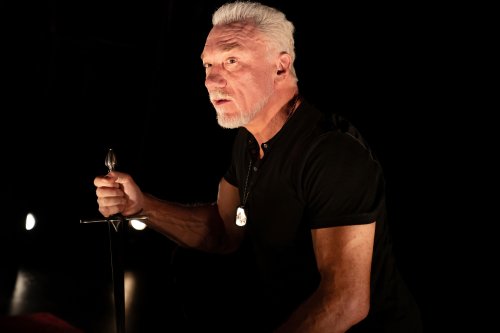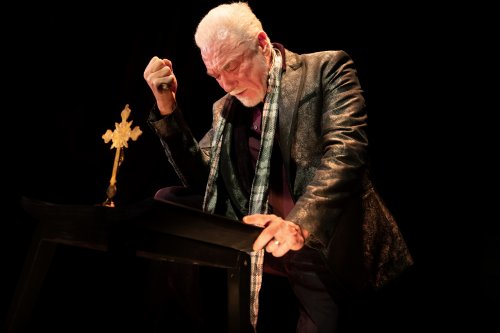All the Devils Are Here: How Shakespeare Invented the Villain
Patrick Page’s absorbing and informative one-man show demonstrating his credible contention that Shakespeare took the Elizabethan "Vice" character and added psychological realism.

Patrick Page in a scene from his one-man show “All the Devils Are Here” at the DR2 Theatre (Photo credit: Julieta Cervantes)
[avatar user=”Victor Gluck” size=”96″ align=”left”] Victor Gluck, Editor-in-Chief[/avatar]
The subtitle of Patrick Page’s absorbing and informative one-man show All the Devils Are Here, “How Shakespeare Invented the Villain” is an actuate description of the content of his presentation. In a kind of lecture-performance it is Page’s credible contention that William Shakespeare took the Vice character (the villain from the Middle Ages’ Morality plays through Christopher Marlowe) and added psychological realism. Eventually in his last play, The Tempest, Shakespeare was dealing with a character with a very worthy justification for revenge who finds compassion and empathy instead.
If anyone has the voice for Shakespearean soliloquies it is Patrick Page with his resonant baritone voice. While most identified with big Broadway musicals, Page has appeared on Broadway in Denzel Washington’s Julius Caesar in 2005, as well as Off Broadway productions of Richard II, Cymbeline and Coriolanus, plus playing King Henry VIII in the 2008 Broadway revival of A Man for All Seasons. In All the Devils Are Here (a quote from Shakespeare’s The Tempest), Page discusses the villains in the canon in chronological order and demonstrates with duologues and soliloquies that prove his point.
Beginning with Lady Macbeth conjuring spirits, he returns to the beginning of Shakespeare’s career with an explanation of The Vice, the middle ages “personification of Sin – like Greed, Envy, Jealousy, or Lust.” As Shakespeare’s father was High Bailiff of Stratford with the responsibility to license plays, we can well imagine that young Will had a front row seat at many of the plays of the time. Page recounts that Shakespeare’s first great villain was Richard III in a speech in which he tells us that he was “simply born to be bad,” but Shakespeare for the first time humanizes a villain.

Patrick Page in a scene from his one-man show “All the Devils Are Here” at the DR2 Theatre (Photo credit: Julieta Cervantes)
Next Page parallels the similarities between a play by the Elizabethan leading Elizabethan playwright before him, Marlowe’s The Jew of Malta, and Shakespeare’sTitus Andronicus. Page gives us parallel speeches from both Marlowe’s Barabas and Shakespeare’s Aaron the Moor which are incredibly similar when placed side by side. (If you are going to steal, why not steal from the best?) Next comes Shylock in The Merchant of Venice, with the warning that in Shakespeare’s times, Elizabethan audiences were rabidly anti-Semitic. Page presents a duologue between Antonio, the title character, and Shylock, the Jewish moneylender, who in those days would have been perceived as the villain. However, according to Page for the first time in history, he is “a villain whose motivation is so clear, whose psychology is so complex, and whose language is so rich that he changes the way we experience villainy itself.” Shakespeare forces us to ask if we had been treated as Shylock was, might we not thirst for the same vengeance as he?
Next we come to Malvolio in Twelfth Night whose name literally means “ill will.” Malvolio’s narcissistic behavior has alienated all around him and the other characters have chosen to take their revenge on him. Page presents the soliloquy in which Malvolio’s misplaced ambitions get the better of him. After the characters take him down more than a peg, his final words in the play are the curse, “I’ll be revenged on the whole pack of you.”
In Shakespeare’s greatest play Hamlet which came next he gets to explore the question “to take revenge, or not take revenge” which seems to have interested him from his earliest plays. Page points out that making the villain King Claudius, the murderer of his brother, go into a chapel and attempt to pray gives the play both a hero and villain who “had a profound sense of right and wrong.” In Measure for Measure, Angelo, the acting Deputy of Verona, has a conscience when he lusts after the nun Isabella but that doesn’t stop him from trying to act on his baser instinct. In a speech that would not be out of place in a contemporary movie, Angelo tells her that no one will be believe her if she tries to expose his villainy.

Patrick Page in a scene from his one-man show “All the Devils Are Here” at the DR2 Theatre (Photo credit: Julieta Cervantes)
Page reminds us that Shakespeare had now spent 15 years “gradually turning his villains from stereotypical comic Vices into three dimensional human beings – and eventually giving them a genuine sense of conscience.” However, when he wrote Iago in The Tragedy of Othello, he went deep into psychopathology, something Page had to investigate when he played the part in Michael Kahn’s production of The Shakespeare Theater Company in Washington, D.C. Presenting a hefty chunk of Iago’s verbal seduction scene of Othello using a lie, he demonstrates to us that Iago has all seven qualities of a man with no conscience.
Although King Lear which comes next features many psychopaths, the bastard Edmund who refuses to accept his lot in life is redeemed at the end when he says, “Some good I mean to do before I go, despite my own nature.” In the tragedy that follows, Page demonstrates that Macbeth is not born evil, but chooses evil revealed to us in a series of soliloquies which Page performs one after the other. In Shakespeare’s final play, the romance called The Tempest, while Prospero, the main character, has ached for revenge for his grievances for 12 years practicing the dark arts, he ultimately chooses to reject the rough magic that he has becomes so proficient at and forgive his persecutors in reconciliation.
Simon Godwin’s direction has Page use various parts of the stage for different sequences as well as props placed in strategic places on Arnulfo Maldonado’s red draped set: a cross, a sword, a cup, a skull, a book. Emily Rebholz’s vaguely Elizabethan costume allows Page to remove layers so he looks different as the performance evolves. The excellent lighting by Stacey Derosier always focuses attention on the right spot on the stage for the next monologue. A fine introduction for those unfamiliar with the Shakespeare canon, All the Devils Are Here: How Shakespeare Invented the Villain is a fascinating review for those who are familiar with the major plays.
All the Devils Are Here: How Shakespeare Invented the Villain (extended through March 31, 2024)
DR2 Theatre, 103 E. 15th Street, in Manhattan
For tickets, call Telecharge at 212-239-6200 or visit http://www.allthedevilsarehereplay.com
Running time: 90 minutes without an intermission






Leave a comment